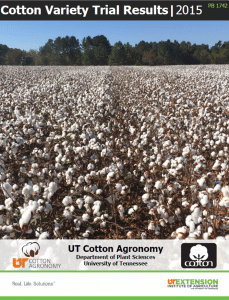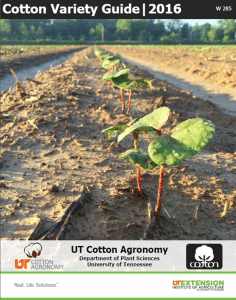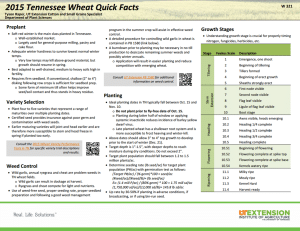Meeting season is in full swing, and there are several educational opportunities fast approaching (see below). Pesticide re-certification points and CCA points will be available at all these meeting. Additional details will be provided soon! Continue reading
Category Archives: Farm Management
Comments on January 12th USDA reports & Profitability Update
U.S. feed grain supplies for 2015/16 are lowered as small increases in corn and sorghum imports and sorghum production are more than offset by a reduction in corn production. Harvested area for corn is raised slightly, but the national average yield is estimated 0.9 bushel per acre lower than the previous forecast at 168.4 bushels per acre. Corn production for 2015/16 is estimated 53 million bushels lower, but remains the third largest crop on record at 13.6 billion. Continue reading at Monthly Crop Comments & Profitability Update.

2015 TN Cotton Variety Trial Results
 The 2015 TN Cotton Variety Trial Results Publication (PB1742) is now available online. This document contains detailed results from all harvested trails in the 2014 University of Tennessee Cotton Variety Testing program. This expanded publication follows the recently published summary publication, 2016 TN Cotton Variety Guide (W285), which was released a few weeks ago. Continue reading
The 2015 TN Cotton Variety Trial Results Publication (PB1742) is now available online. This document contains detailed results from all harvested trails in the 2014 University of Tennessee Cotton Variety Testing program. This expanded publication follows the recently published summary publication, 2016 TN Cotton Variety Guide (W285), which was released a few weeks ago. Continue reading

2016 TN Cotton Variety Guide
The 2016 TN Cotton Variety Guide is now available  online. This document summarizes results from the 2015 University of Tennessee Cotton Agronomy program and serves as a precursor to a full release of trial results in PB 1742 to come within the next few weeks. Summaries from the 2015 season were calculated from four Official Variety Trials (OVTs), four large, replicated on-farm trials and nine County Standard Trials (CSTs) scattered throughout TN’s cotton producing counties. Continue reading
online. This document summarizes results from the 2015 University of Tennessee Cotton Agronomy program and serves as a precursor to a full release of trial results in PB 1742 to come within the next few weeks. Summaries from the 2015 season were calculated from four Official Variety Trials (OVTs), four large, replicated on-farm trials and nine County Standard Trials (CSTs) scattered throughout TN’s cotton producing counties. Continue reading
Comments on USDA WASDE Report and Profitability Outlook
December 9, 2015 – USDA World Supply and Demand Estimates
by Dr. Aaron Smith & Chuck Danehower
Corn
Projected U.S. feed grain ending stocks for 2015/16 are raised slightly this month. U.S. corn use for ethanol production in 2015/16 is projected 25 million bushels higher based on the strongerthan-expected pace of ethanol production during November as indicated by weekly data from the Energy Information Administration (EIA). EIA also raised its forecasts for 2015 and 2016 gasoline consumption in the December Short-term Energy Outlook. Corn exports for 2015/16 are projected 50 million bushels lower, reflecting the slow pace of sales and shipments to date and higher projected exports for Brazil and Canada. U.S. corn ending stocks are projected 25 million bushels higher at 1,785 million bushels. Continue reading at Monthly Crop Outlook.
Comments on USDA WASDE & Profitability Outlook Update
November 10, 2015 – USDA World Supply and Demand Estimates
Corn
Projected 2015/16 U.S. feed grain supplies are raised this month on higher forecast production for corn and sorghum. Corn production is forecast 99 million bushels higher with the national average yield raised 1.3 bushels per acre to 169.3 bushels, just 1.7 bushels below last year’s record. Projected domestic corn use for 2015/16 is lowered 50 million bushels as a 25-millionbushel increase in expected feed and residual use, with the larger crop and lower expected prices, is more than offset by a 75-million-bushel reduction in corn used to produce ethanol. Continue reading at Monthly Crop & Profitability Outlook .
Get Ready To Expand
Are you considering expanding your farm operation? Will expansion opportunities be available in your area? If so, then this article from AgWeb could offer some insight.
Build your operation with input from partners, bankers and balance sheets
Farm operations mature in the same way children grow up: gradually. Best-in-class producers who have expanded their footprint understand the value of carefully studying whether growth will help their bottom line or cause it to falter. Executed properly, growth can create efficiencies and open the door to new markets, even in a down economy. Continue reading at AgWeb.
2015 Tennessee Wheat Quick Facts now available
 Now available online, the 2015 Tennessee Wheat Quick Facts Publication (W 321) is designed to be a single page (printed front/back) summary of the most pertinent Continue reading
Now available online, the 2015 Tennessee Wheat Quick Facts Publication (W 321) is designed to be a single page (printed front/back) summary of the most pertinent Continue reading

